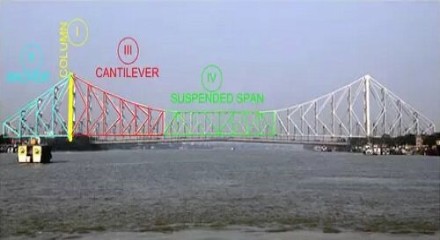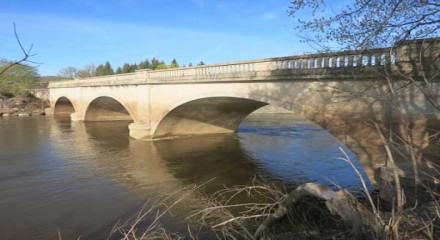Bridges are an integral part of the infrastructure for the economic growth of the country and therefore they cannot remain static in relation to a growing economy. With the increase in population and growth in industrial and agricultural output, bridges along with railways have to keep pace with the developments through provision of transport facilities in areas where these have been lacking and increased facilities where these are inadequate to meet the demands of the travelling public as well as those of the industrial and agricultural sectors.
The continuous improvement in bridge systems is an important indication of the current scientific and technological revolution which has a direct bearing on the progress of productive forces. Bridges play a vital role in shaping the history of a country as the existence or otherwise of these bridges very much affect the movement of troops during the hostilities and consequently these bridge points are required to defend ourselves from the onslaught of the invaders. No road system is considered complete in itself without the provision of such cross drainage works in the form of bridges, so that there is no hindrance to the free flow of traffic, especially during the rains.
Many types of bridges have been constructed from the times of olden days ranging from the timber bridges to modern steel and pre-stressed concrete bridges. The modern bridges are usually constructed of steel, being durable and easy to fabricate. The high tensile steel used has minimum tensile strength of 55 kg/mm. The bolts and nuts used in the bridge are of mild steel having tensile strength of not less than 44 kg/mm. The type of steel bridge to be used depends on the span.
Types of Bridges
- Cable stayed bridge
- Wooden bridge
- Floating bridge
- Movable bridge
- Suspension bridge
- Cantilever bridge
- Truss bridge
- Arch bridge
- Composite bridge.
Cable stayed bridges
Cable stayed bridges are usually constructed over gorges in hilly countries where the water flow in the stream below is very fast. Cable stayed bridges are constructed with boulders where piers cannot be easily constructed. These bridges have a span of 150 metres and are usually meant for pedestrian traffic. The deck is supported by long cables carried over tall towers provided at their ends.
Timber bridges
Timber bridges are temporary constructions to cross streams and obstacles, specially built in forest areas where timber is available in abundance, and also where speedy erection is required as in times of war. When the materials for constructing permanent bridges are not available or the same are available at long distances entailing huge cost of construction, these wooden bridges are suitable and cheaper. Timber bridges have a life-span of about 15 years and may require replacement thereafter.
They are likely to be destroyed by fire and fungus growth if not properly maintained. They are suitable for small spans of 5 metres or so. The state Jammu and Kashmir has several such wooden bridges constructed many years ago. Bridges constructed purely of timber may have either timber arch construction or be of strutted beam type. The points to be borne in mind while deciding the construction of timber bridges are:
- Duration of time for which the bridge is required
- Amount of load required to be carried
- Quality of timber available
- Method of erection.1
Floating bridges
Floating bridges, also known as pontoon bridges, are temporary structures constructed over rivers in times of emergency during wars where the time is of fundamental importance. The advantage of these floating bridges is that they can be erected very quickly as the component parts of the bridge are of pre-fabricated types as per the dimensions approved by the Indian Road Congress and hence can also be dismantled in a very short time. The materials used for the parts are strong, durable and non-corrosive.
Movable bridges
As stated before, bridges are also classified according to the method of giving clearance to navigation.
Under that classification, movable bridges are of the following four types, namely:
- Swing bridges
- Bascule bridges
- Lift bridges
- Transporter bridges
Swing bridges: In case of swing bridges there is a disc bearing placed over the central pier on which two pans of continuous trusses are provided. By an arrangement of rotating gear, the whole truss rotates horizontally through 90° when its axis becomes parallel to the direction. Of flow of water and at that position pedestrians or other vehicles cannot move.
Bascule bridges: A rough idea of the working of a bascule bridge can be had from the common toll tax barrier arrangement in India where a full span pole can be lowered and raised with the help of a counterweight placed at one end. In a bascule bridge, instead of the pole, there is provided a hinged truss which can be raised or lowered in a vertical plane with the help of a counterweight or rack and pinion arrangement or by cables. A general view of single and double bascule bridges is
Lift bridges: For wide channels the bascule bridges are not economical. In such cases the vertical lift bridges are recommended to give clearance to navigation. A vertical lift consists of a road way truss which is lifted up by means of cables passing over pulleys attached to each of the two tall towers erected at either ends. These cables are connected to counterweights at the other end.
Transporter bridges: In case of transporter bridges, a moving cage is suspended from an overhead truss with the help of a cable or wire ropes. The overhead truss rests on two towers and it contains rails for the cage to roll. The cage is loaded with persons or goods and it is then allowed to move from one end to the other end of river. This type of bridge is used within a harbour area to provide an arrangement for shifting of men and materials across a channel.
Suspension bridges
Suspension bridges are long-span bridges involving creative works and great skill on the part of the bridge engineer. For the stability of such long-span bridges of 600 m and above, considerations for the control of aerodynamic movement, the local angle changes in the deck and vertical oscillations caused by serve winds are of vital importance, failing which a failure of the bridge may result.

Cantilever bridges
Cantilever bridges, due to their heavier weights and labour involved in construction compared to the cable stayed bridges for the same spans, are no longer popular. It is so called as in a single span there are cantilever arms from each pier to the ends where the freely supported suspended span rests. Then there are anchor arms at either end between the abutment and the pier.

Truss bridges
For rail-road or long railway bridges of spans 100 to 200 meters, truss bridges are found suitable and expedient due to relative lightness of its component parts. There are various types of truss bridges like the Warren truss bridge, Pratt truss and N-truss, but the most common form is the Warren truss type.

Arch bridges
In case of arch bridges, the abutments must be strong enough to carry the thrust exerted by the ribs in such cases heavy expensive abutments will be required, unless there is a gorge with rocky banks which might be strong enough to bear the load exerted by the ribs; and it is in such situations where arch bridges are most recommended. Arch bridges may be made of masonry or steel. Masonry arch bridges are not recommended for spans exceeding 6 metres, especially in seismic zones. For long spans, steel arch bridges are generally used. The arch bridges may be rigid, of two hinge or three hinge type.
